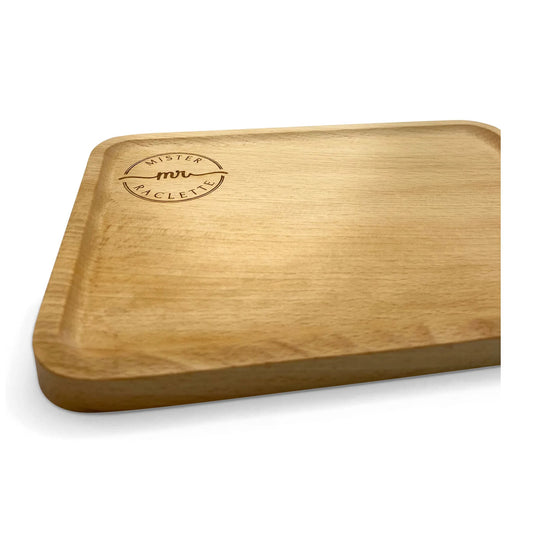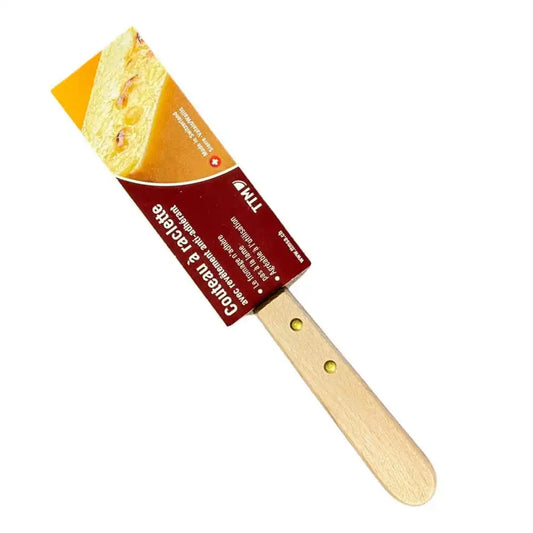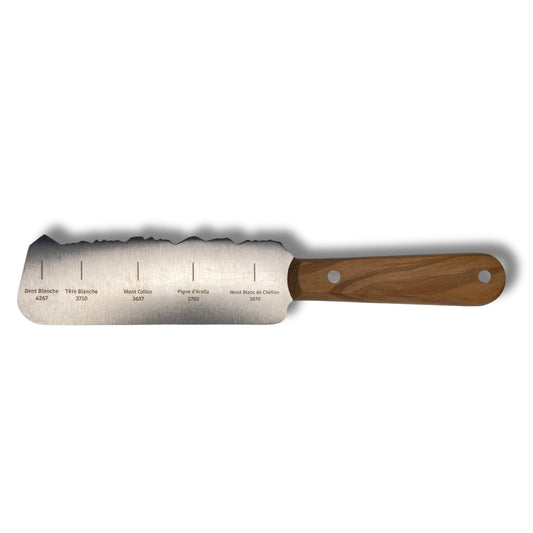The process of making raclette
Making Raclette Cheese
Detailed process of making Valais raclette cheese
Raclette cheese, a true emblem of Swiss gastronomy, is the fruit of artisanal know-how passed down from generation to generation. Specially protected by the AOP " Raclette du Valais ", this cheese is produced exclusively from raw milk and according to rigorous techniques that respect tradition. This article explores in depth each stage of its production, from milking the cows to maturing, based solely on documented facts. The production of Valais Raclette cheese perfectly illustrates the harmony between centuries-old traditions and modern quality requirements.
Cow Feeding and Milk Quality

Raw milk , an essential ingredient in the production of Valais Raclette cheese. It comes from cows fed 75% with fodder produced in the geographical area of the PDO. The use of silage is strictly prohibited, guaranteeing optimum milk quality. Each cow benefits from a natural diet which directly influences the richness of the Raclette cheese.
Farmers play a crucial role in selecting and storing fodder to ensure a balanced diet that meets the PDO criteria. Seasonal variations also influence the composition of the milk, adding a diversity of flavours to raclette cheese. In summer, when the cows graze freely in the mountain pastures, their feed enriches the milk with unique floral aromas.
A historical anecdote tells that, in the Valais of the Middle Ages, shepherds went up with their flocks to the mountain pastures during the summer months. These shepherds, far from the villages, always took raclette cheese with them. Not only for its nutritional value but also for its ability to be melted on an improvised fire. This tradition has endured and has become a true gastronomic icon.
After milking, the milk is cooled to less than 8°C within two hours. This milk is delivered once or twice a day to the cheese dairy. It must be used within 24 hours of collection, respecting the freshness standards required by the AOP. The quality of the raw milk is checked at each stage to ensure that it meets the high standards of Valais AOP Raclette cheese production.
Maturation and bacterial cultures

Raw milk is poured into a copper vat, a material that promotes excellent thermal conductivity. While allowing optimal interaction with lactic bacteria. Bacterial cultures, such as RA 401, are added to stimulate acidification and prevent the development of unwanted germs. The milk is heated to 32 °C and left to rest for 30 to 60 minutes. A crucial pre-maturation time to define the final taste of the hard raclette cheese.
This step is also influenced by the initial quality of the milk, which must contain a balanced natural microbial flora. The bacteria introduced during maturation play a determining role in creating the specific aromas of raclette cheese. The bacterial culture also contributes to the homogeneous hard texture of raclette cheese, essential for its ability to melt evenly.
Renneting and coagulation

Once the maturation is complete, the rennet, from the calf's abomasum, is incorporated into the milk at a temperature of 30 to 33 °C. This delicate step, called renneting, causes the milk to coagulate, transforming the liquid into a solid mass of curd in about 30 minutes. The quality of this curd is decisive for the rest of the process.
Another local story reports that the first Valais cheesemakers used improvised rennets, from local wild plants. This ancient method, although less precise, shows how the production of raclette has adapted over time. To integrate innovations while respecting traditions.
Master cheesemakers perform a visual and tactile check of the curd to ensure that it has reached the right consistency. Any variation in coagulation can affect the texture and taste of the final product. Renneting is a phase where the cheesemaker's experience and intuition are particularly called upon, as each batch of milk can react slightly differently.
Cheese curing, stirring and characteristics

The curd is obtained by cutting the curd into regular grains, the size of a grain of rice or corn (using a curd slicer). This precise cutting, called decaillage, allows the whey to be removed while preserving the properties of the future raclette cheese. The mixture is gradually heated to between 36 and 45 °C to firm up the grains, then stirred for about 30 minutes to ensure a uniform texture.
The curdling and stirring directly influence the melting capacity of the raclette cheese, an essential criterion for raclette. The curd grains must maintain a perfect balance between firmness and elasticity. Mastering these steps guarantees a characteristic of the cheese with a melting and creamy final texture, ideal for a convivial raclette.
Molding and pressing

In the rest of the production, the curd grains are then collected in molds. These simple wheels of cheese undergo a progressive pressing for at least four hours, with several careful turnings of the mold to ensure even draining. During this stage, the pH is precisely controlled, which must be between 4.8 and 5.2 to guarantee a perfect texture and taste.
The choice of molds and the pressure applied during this step influence the internal structure of the hard raclette cheese. Insufficient pressing can result in air pockets, while excessive pressing can make the cheese too dense. The wheels thus formed are ready to enter the salting phase, where they will acquire their protective rind and characteristic flavor.
Salting: immersion in brine

Salting, an essential step in the manufacturing process. It can be done by hand or by immersing the wheels in a bath of concentrated brine (18 to 22 °Bé) at a temperature of 8 to 15 °C. This immersion lasts about 24 hours and fulfills several functions: strengthening the crust, refining the flavor and acting as a natural preservative by limiting the development of unwanted bacteria.
Salt also plays a role in the water balance of raclette cheese, influencing its ability to age properly. The concentration and duration of the salt bath are adjusted according to the size of the wheels. Insufficient salting could compromise the ripening process, while too much salt could overpower the natural flavors of the raclette cheese.
Refining: patience and know-how

After salting, the wheels are placed in maturing cellars, where they will remain for a minimum period of three months. The conditions are strictly regulated: a temperature between 7 and 14 °C and a humidity of 88 to 96%. The cheeses are turned daily for the first ten days, then two to three times a week thereafter.
They are also rubbed regularly with a salt solution enriched with Brevibacterium linens. A key bacteria for developing morge, this characteristic orange crust that contributes to the unique flavor of raclette cheese.
Maturing is a phase where the cheesemaker's experience is essential. Variations in temperature and humidity can alter the final characteristics of the raclette cheese. The aromas, texture and colour evolve slowly over the weeks. Matured cheeses reveal complex notes that delight lovers of Valais AOP raclette. The more matured the cheese, the less lactose it will have (lactose removal phase)
A crucial element of this step is the affixing of a quality seal on each wheel. This seal, specific to each cheese dairy, makes it possible to identify the origin of production and the exact date of manufacture. This marking guarantees the traceability of the cheese and offers total transparency to the consumer. In some cheese dairy, this seal also becomes a sign of local pride, a trademark, highlighting the unique know-how of the establishment.
The temperature cycle and control of the stages of cheese making
Each step in the production of raclette cheese is associated with precise temperatures, which play a key role in the final result. Coagulation, de-coating, heating and even ripening follow a strict logic, guaranteeing the texture, flavor and quality of the finished product. This meticulous temperature control is a know-how passed down from generation to generation.
Modern tools allow master cheesemakers to monitor and adjust these parameters with great precision, while respecting artisanal traditions. This combination of innovation and respect for traditional practices is at the heart of the success of Raclette du Valais AOP.
Conclusion
The production and characteristics of raclette cheese is an art where every detail counts. From the quality of the raw milk to the maturing in the cellar. This meticulous process, based on ancestral techniques and rigorous standards, gives birth to an exceptional product. Which is the pride of Valais and delights raclette cheese lovers around the world. Each bite of raclette is an immersion in the Swiss cultural and gastronomic heritage, recalling the deep link between man, nature and artisanal know-how.
Respect for these traditions ensures that raclette cheese remains a timeless culinary treasure, appreciated far beyond the Swiss borders. This living heritage continues to evolve, while remaining faithful to its origins, to the great delight of raclette lovers. Enjoy your tasting.









